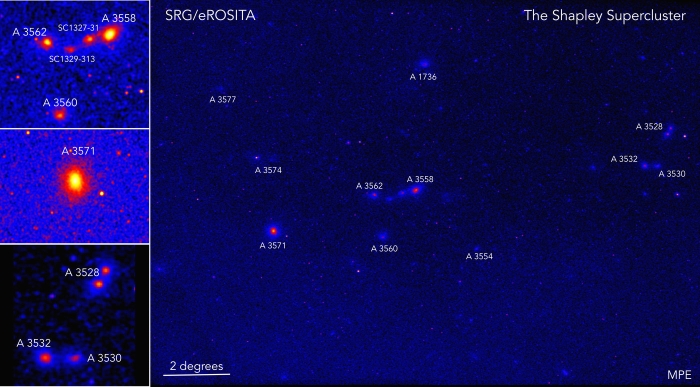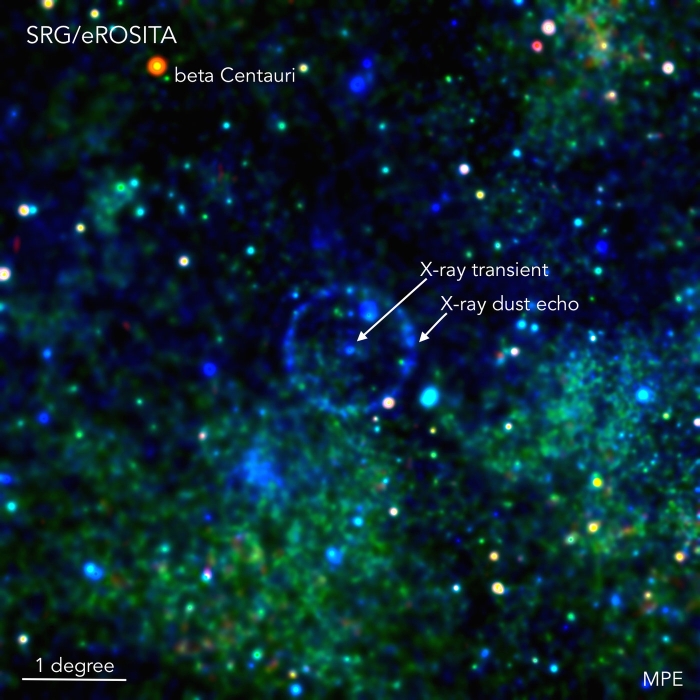A space telescope launched in July 2019 has just completed its first survey. For months, the eROSITA telescope aboard the Spektr-RG space observatory has been scanning the entire sky, collecting observations for the deepest all-sky survey in X-ray wavelengths.
Now, all those data have been compiled into a map containing over 1 million bright X-ray objects - approximately doubling the number of such objects from the entire 60 years of X-ray astronomy prior.
"This all-sky image completely changes the way we look at the energetic universe," said astrophysicist Peter Predehl, eROSITA principal investigator at the Max Planck Institute for Extraterrestrial Physics (MPE).
"We see such a wealth of detail - the beauty of the images is really stunning."
Most astronomical objects emit X-rays, but in different proportions to other wavelengths. X-rays have very short wavelengths, and are therefore very high energy - emitted by the hottest and most energetic objects, like black holes, neutron stars, quasar galaxies, and supernova remnants.
 The Vela supernova remnant. (Peter Predehl, Werner Becker/MPE, Davide Mella)
The Vela supernova remnant. (Peter Predehl, Werner Becker/MPE, Davide Mella)
X-rays are invisible to the naked human eye, like radio waves. So, the sky in X-ray looks very different from what we see when we look up at night. In addition, and unlike radio waves, X-rays are mostly blocked by Earth's atmosphere, so the only way we can study them is by sending telescopes into space.
A number of X-ray telescopes have been deployed, but the most recent X-ray all-sky survey was conducted decades ago, from 1990 to 1999 by the ROSAT satellite. The new sky map collected by the joint German-Russian eROSITA is, the team says, four times deeper than the map extracted from ROSAT data.
It's been painstaking work. The Spektr-RG space observatory is in one of Earth's Lagrangian points, a gravitationally stable pocket created by the interaction between Earth and the Sun, about 1.5 million kilometres away.
The instrument collected 182 days' worth of data, each exposure between 150-200 seconds, totalling 165 gigabytes. Each day, the team would connect to the satellite to downlink what it had collected. Then all those raw data had to be processed and put together.
 The Shapley Supercluster of galaxies. (Esra Bulbul, Jeremy Sanders/MPE)
The Shapley Supercluster of galaxies. (Esra Bulbul, Jeremy Sanders/MPE)
"We were all eagerly awaiting the first all-sky map from eROSITA," said astrophysicist Mara Salvato of MPE. "Large sky areas have already been covered at many other wavelengths, and now we have the X-ray data to match. We need these other surveys to identify the X-ray sources and understand their nature."
Most of the sources in the map - around 77 percent - are supermassive black holes actively accreting material in the cores of galaxies, or what we call active galactic nuclei. These objects are extremely energetic, and there are a lot of them out there.
There are also clusters of galaxies, glowing in X-rays because of the hot gas constrained by their collective gravity; these make up around 2 percent of the objects.
Other objects are a lot closer to home. Within the Milky Way, stars with hot, magnetically active coronae make up 20 percent of the objects. The remaining one percent is made up of an assortment - bright X-ray binaries, supernova remnants, and flares, such as those emitted by stars torn apart by black holes.
 (Georg Lamer/Leibniz-Institut fur Astrophysik Potsdam, Davide Mella)
(Georg Lamer/Leibniz-Institut fur Astrophysik Potsdam, Davide Mella)
The map also reveals the structure of the hot gas within the Milky Way galaxy, and the gas that surrounds it. It's a wealth of data poised to unlock a great deal of insight into the X-ray Universe. And it's just the beginning. Over the next few years, the observatory will conduct seven more surveys, which will combine for a vastly more sensitive overall map of the sky.
"With a million sources in just six months, eROSITA has already revolutionised X-ray astronomy, but this is just a taste of what's to come. This combination of sky area and depth is transformational," said astrophysicist Kirpal Nandra of MPE.
"We are already sampling a cosmological volume of the hot Universe much larger than has been possible before. Over the next few years, we'll be able to probe even further, out to where the first giant cosmic structures and supermassive black holes were forming."
We can't wait.
#Space | https://sciencespies.com/space/this-is-what-the-entire-sky-looks-like-through-x-ray-eyes/
No comments:
Post a Comment